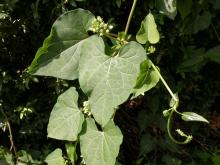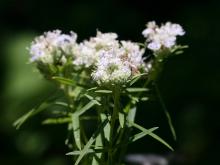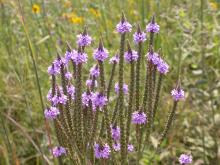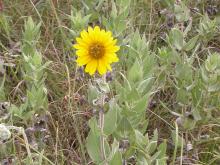Wildflowers, Grasses and Other Nonwoody Plants
Media

Species Types
Scientific Name
Heliopsis helianthoides
Description
Ox-eye is a sunflower lookalike. This member of the sunflower family is not a true Helianthus, but a Heliopsis. This attractive perennial is growing in popularity as a native garden flower.
Media

Species Types
Scientific Name
Helianthus tuberosus
Description
Jerusalem artichoke deserves a better common name. This tall native sunflower has edible tubers and great crop potential, but it has never been very big commercially. Fortunately, we can enjoy it for free in nature.
Media

Species Types
Scientific Name
Cynanchum laeve
Description
Bees, butterflies, and other insects love its nectar, but sand vine is also a problem weed that can be difficult to eradicate. Some people cultivate it as an ornamental. Beekeepers value it as an excellent honey plant.
Media

Species Types
Scientific Name
Asclepias syriaca
Description
Common milkweed is famous as a food plant for monarch butterflies. It bears curious seedpods bearing seeds that fly on silky parachutes. It's common statewide in a variety of habitats.
Media

Species Types
Scientific Name
Pycnanthemum tenuifolium
Description
Slender mountain mint has smooth, square stems, opposite, narrow leaves, and dense heads of 2-lipped white (or lavender) flowers. Aromatic and minty, it can be grown at home in the herb garden, and its leaves used for seasoning food.
Media

Species Types
Scientific Name
Verbena hastata
Description
Blue vervain is a tall, slender, erect perennial with branching stems and rough hairs. Its tubular flowers are clustered in many terminal spikes, and can be deep purple, violet, light lavender, or rarely white.
Media

Species Types
Scientific Name
Teucrium canadense
Description
Like most other mints, American germander has square stems, opposite leaves, and two-lobed flowers. The unusual configuration of the corolla lobes is the key identifying characteristic.
Media

Species Types
Scientific Name
Silphium integrifolium
Description
Wholeleaf rosinweed looks like a sunflower, but its relatively small central disk of infertile florets reveals it as a rosinweed, genus Silphium. It occurs statewide.
Media

Species Types
Scientific Name
Helianthus mollis
Description
Ashy sunflower is relatively short compared to others in its genus. Its leaves are grayish, hairy, sessile, and broadly oval. Its colonies are common in upland prairies in the southern half of the state.
Media

Species Types
Scientific Name
Asclepias hirtella
Description
Prairie milkweed’s full, rounded clusters of small, delicately purple-tinged flowers set it apart from other prairie milkweeds.
See Also
About Wildflowers, Grasses and Other Nonwoody Plants in Missouri
A very simple way of thinking about the green world is to divide the vascular plants into two groups: woody and nonwoody (or herbaceous). But this is an artificial division; many plant families include some species that are woody and some that are not. The diversity of nonwoody vascular plants is staggering! Think of all the ferns, grasses, sedges, lilies, peas, sunflowers, nightshades, milkweeds, mustards, mints, and mallows — weeds and wildflowers — and many more!





















